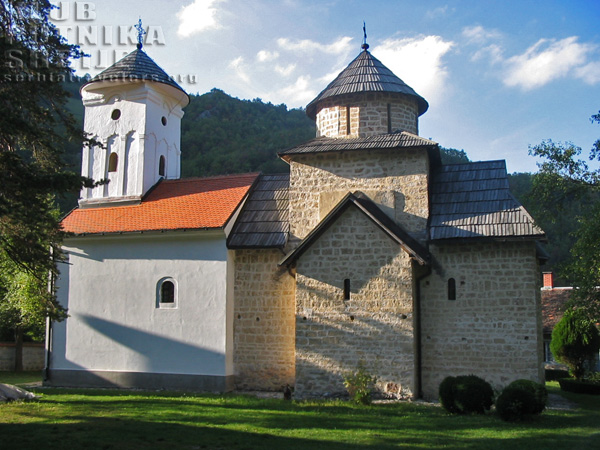Pustinja Monastery
Pustinja Monastery lies in the canyon of the Jablanica River, about 20 km from the city of Valjevo, at the beginning of Pustinja Gorge. The church is dedicated to the Purification of the Mother of God, and a legend has it that it was built during the reign of the Serbian king Dragutin in the 13th century.
The monastery lies in a little hidden valley surrounded by steep hills. The medieval part of the church is made of stone with the oak roof. The whitewashed parvis with a bell-tower was added in the mid 19th century. The church is especially interesting for its completely preserved medieval frescoes. 
History of Pustinja Monastery
It is unknown who founded the monastery. The first mention of the church in this exact spot dates from 1572.
There's a local folk legend saying that the churches Jovanje, Gracanica and Pustinja were built by three brothers. When the churches were finished, the brothers wanted to show each other what they have made. So, when they reached Pustinja (meaning "desert"), the foundation of the youngest brother, amazed by its beauty, the older brothers jealously cursed him: “Why didn’t you tell us to build a church as beautiful as yours? Let it become deserted!”
Excavations that were done here after the renovation of the temple proved that the church was built on the foundations of a much older church. During these excavations parts of the foundation and an unidentified tomb, much older than the church itself, were discovered.
In the old days you could only reach the church following a narrow steep path cleft into the Bela Stena rock. In 1962 a narrow concrete road was built leading from Pocuta village. Today it serves as the main road to the monastery.
In spite of its inaccessibility, the Turks managed to damage the monastery more than once. It was damaged in 1683 during the invasion of Turkish army to Vienna. It became deserted during the Koca’s Uprising, when Busatli-Pasha burned it down. Pustinja is today an active female monastery.
Getting to Pustinja Monastery
Pustinja Monastery is located near Pocuta village, about 19 km from Valjevo. There are four daily busses connecting Valjevo and Pocuta. When you get to the village, you have another 3 km to the monastery, which makes a nice half-hour walk.
If you take the new road going from Valjevo in the direction of Bajina Basta, just where the road exits the Pocuta village a narrow road branches off to the right. Following the road for another 3 km, you will arrive to a small hidden valley surrounded by hills. The monastery can only be seen when you arrive within couple hundred meters from it.
{tab=things to see}What to see in Pustinja Monastery?
When you enter the monastery grounds, just after the gate, you will see the spring of drinking water on your right, with a fountain erected in 1902.
Merged with the rugged landscape around it, Pustinja Monastery looks like an inseparable part of woods and rocky cliffs.
The main church dedicated to the Purification of the Holy Mother of God is built in Serbian Rascian architectural style. It was built from crashed and chiseled stone, and the roof is covered with oak wood. The church has one cylindrical dome with narrow windows.
The whitewashed parvis from 1848 is in every way different from the old church, making it look like two buildings standing next to each other.
The interior of the church was decorated in a very short time, from March 15th till June 25th 1622, in times of prior Janicije Bitojevic, as can be read from the inscription on the west entrance. The painters Nikola and Jovan are signed in the niche of Proskomedia on the sarcophagus from which the face of dead Christ emerges.
The medieval frescoes cover not only the inner walls, but also the facade. On the north facade there is a fresco of the Holy Mother of God with the child Christ, known among the local floks as "the quickhelper" because it "helps with the everyday problems".
The frescoes in the church interior are very diverse, vivid and well preserved. You can see the images of St. Peter and Paul, John the Baptist, Serbian saints St. Sava and his father St. Simeon, and opposite of them are St. Pantelejmon and Damjan. On the south wall, beside the composition representing the founder, abbot Joakim, offering the model of Pustinja Monastery to the Mother of God, there is a picture of St. Anthony the Great, and on the west wall, as a guardian of the entrance, the archangel Michael with his unsheated sword is shown.
Also very interesting are the frescoes representing St. Constantine and Helene, then the great compositions “The Mocking of Christ”, “Betrayal of Judah”, ”Entering Jerusalem”, ”Christ's Descent to Hell”, “Christ at the Pilate’s court”, “Purification of the Holy Mother of God”, etc.
In the south wall of the parvis, some icons from the 17th century can be seen: in the emperor’s doorway, except for the common scene of “Annunciation”, you can also see a composition of the “Purification of the Mother of God”, as well as the architrave with a scene representing “The Hospitality of Abraham”. Above the altar screen made of brick there is an original iconostasis with a crucifix.
The monastery boasts an iconostasis made of brick, which is very unusual. The frescoes of St. John with wings and St. Silvestre the Martyr are of great importance because they can’t be seen in any other Serbian Orthodox church.
{tab=where to sleep?}Where to sleep in Pustinja Monastery?
There is a dormitory in the monastery, but at the moment we don’t have any information about the possibilities of lodging there. Since the monastery is only 6 km away from Valjevo and there are 4 daily buses between Valjevo and the monastery, you can sleep in Valjevo.
{/tabs}
